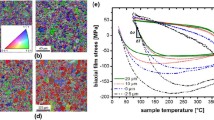Abstract
Strain evolution in 0.45-μm-thick, 2-μm-wide, and 100-μm-long Cu conductor lines with a passivation layer has been investigated using synchrotron x-ray microdiffraction. A moderate electromigration-current density of 2.2 × 105 A/cm2 was used to minimize Joule heating in the Cu conductor lines. After 120 h of current flowing in the Cu lines at 270 °C, measurements show strain relaxation and homogenization occurring in the Cu lines with current flowing, but not in Cu conductor lines without current. Stronger interaction between electrons with Cu atoms in areas with higher strains was proposed to explain the observation.






Similar content being viewed by others
References
H.B. Huntington and A.R. Grone: Current-induced marker motion in gold wires. Phys. Chem. Solids 20, 76 (1961).
C.S. Hau-Riege: An introduction to Cu electromigration. Microelectron. Reliab. 44, 195 (2004).
V. Sukharev and E. Zschech: A model for electromigration-induced degradation mechanisms in dual-inlaid copper interconnects: Effect of interface bonding strength. J. Appl. Phys. 96, 6337 (2004).
C-K. Hu, L. Gignac, E. Liniger, B. Herbst, D.L. Rath, S.T. Chen, S. Kaldor, A. Simon, and W-T. Tseng: Comparison of Cu electromigration lifetime in Cu interconnects coated with various caps. Appl. Phys. Lett. 83, 869 (2003).
G.S. Cargill III: Microdiffraction and microfluorescence studies of electromigration-induced stresses and composition changes. AIP Conf. Proc. 612, 193 (2002).
G.E. Ice and B.C. Larson: 3D x-ray crystal microscope. Adv. Eng. Mater. 2, 643 (2000).
H. Zhang, G.S. Cargill III, Y. Ge, A.M. Maniatty, and W. Liu: Strain evolution in Al conductor lines during electromigration. J. Appl. Phys. 104, 123533 (2008).
P.-C. Wang, G.S. Cargill III, I.C. Noyan, and C-K. Hu: Electromigration-induced stress in aluminum conductor lines measured by x-ray microdiffraction. Appl. Phys. Lett. 72, 1296 (1998).
B.C. Valek, J.C. Bravman, N. Tamura, A.A. MacDowell, R.S. Celestre, H.A. Padmore, R. Spolenak, W.L. Brown, B.W. Batterman, and J.R. Patel: Electromigration-induced plastic deformation in passivated metal lines. Appl. Phys. Lett. 81, 4168 (2002).
I.A. Blech: Electromigration in thin aluminum films on titanium nitride. J. Appl. Phys. 47, 1203 (1976).
A.S. Budiman, W.D. Nix, N. Tamura, B.C. Valek, K. Gadre, J. Maiz, and J.R. Patel: Crystal plasticity in Cu damascene interconnect lines undergoing electromigration as revealed by synchrotron x-ray microdiffraction. Appl. Phys. Lett. 88, 233515 (2006).
J.-S. Chung and G.E. Ice: Automated indexing for texture and strain measurement with broad-bandpass x-ray microbeams. J. Appl. Phys. 86, 5249 (1999).
E. Kreyszig: Advanced Engineering Mathematics, 8th ed. (John Wiley & Sons, Inc., 1999), p. 1110.
H. Conrad and A.F. Sprecher: Dislocations in Solids, edited by F.R.N. Nabarro (Elsevier Science Publications BV, 1989), p. 497.
E.E. Vdovin and A.Yu. Kasumov: Direct observation of electrotransport of dislocations in a metal. Sov. Phys. Solid State 30, 180 (1988).
W.D. Callister Jr.: Materials Science and Engineering: An Introduction (John Wiley & Sons, 2003).
L.E. Moyer, G.S. Cargill III, W. Yang, B.C. Larson, and G.E. Ice: X-ray microbeam diffraction measurements in polycrystalline aluminum and copper thin films, in Thin Films—Stresses and Mechanical Properties X, edited by S.G. Corcoran, Y.-C. Joo, N.R. Moody, and Z. Suo (Mater. Res. Soc. Symp. Proc. 795, Warrendale, PA, 2004), U1.7, p. 15.
Acknowledgments
The authors of this study thank Dr. C-K. Hu at the IBM T.J. Watson Research Center for useful guidance and for providing the Cu conductor line samples. Dr. W. Liu from Argonne National Laboratory provided valuable assistance with the synchrotron x-ray microdiffraction measurements and data analysis.
Author information
Authors and Affiliations
Corresponding author
Rights and permissions
About this article
Cite this article
Zhang, H., Cargill, G. Electromigration-induced strain relaxation in Cu conductor lines. Journal of Materials Research 26, 498–502 (2011). https://doi.org/10.1557/jmr.2011.2
Received:
Accepted:
Published:
Issue Date:
DOI: https://doi.org/10.1557/jmr.2011.2




